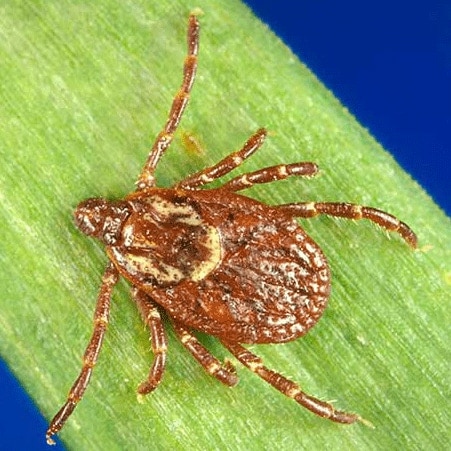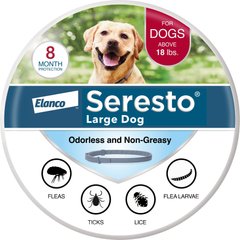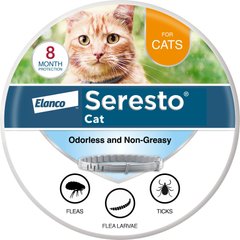When Is Tick Season?

Photo by Nataba/iStock/Getty Images Plus
Making sure our animals get plenty of fresh air and exercise is a top priority when it comes to pet health—but creepy crawlies like fleas and ticks are a very real threat when it comes to keeping our fur babies in tip-top condition. We can’t keep them inside and away from all insects and parasites, but being armed with info about tick season can help us take measures against tick-borne illnesses.
We spoke with vet experts to learn about when tick season takes place, how to prevent tick bites on pets and what to do if a pet does get a tick (which happens!).
When Is Tick Season in Your State?
Ticks are most active during the warmer months, typically from April to September, according to the Centers for Disease Control and Prevention (CDC). Colder states that start to see freezing temperatures in the fall and experience them until early spring have a lower risk of tick infestations during the months of December and January. However, in milder regions (like the southern states or on the west coast), ticks can be found any time of year, says Dr. Bethany Hsia, DVM, a veterinarian and co-founder of CodaPet, in Fresno, CA. In fact, according to the CDC, certain species of adult ticks, such as deer ticks, may be out searching for a host any time winter temperatures are above freezing.
While we’re offering some guidelines on tick season below (per the CDC and our vet experts Dr. Hsia and Dr. Raymond Spragley, DVM, CCRT, CVA, an integrative veterinarian at Zen Dog Veterinary Care in Tuckahoe, NY), it’s best to always be on guard and protect your pet from ticks year-round—no matter your location. The bottom line is, if you’re spending time outdoors, be aware that ticks could be present.
| Tick Season (Months) | States Affected |
|---|---|
| Year-round | Alabama, Arizona, California, Florida, Georgia, Hawaii, Louisiana, Mississippi, Nevada, North Carolina, Oregon, South Carolina, Texas, Washington |
| Early March-November | Alaska, Arkansas, Colorado, Connecticut, Delaware, Idaho, Illinois, Indiana, Iowa, Kansas, Kentucky, Maine, Maryland, Massachusetts, Michigan, Minnesota, Missouri, Montana, Nebraska, New Hampshire, New Jersey, New Mexico, New York, North Dakota, Ohio, Oklahoma, Pennsylvania, Rhode Island, South Dakota, Tennessee, Utah, Vermont, Virginia, West Virginia, Wisconsin, Wyoming |
What Are the Most Common Ticks in the US? And Where Are They?

CDC; pictured: American dog tick
There are many different species of ticks throughout the world. However, only a few of these species bite and transmit pathogens such as bacteria, viruses or parasites that are dangerous to people and pets, according to the CDC. The species outlined in the chart below are the ones in the US to be on the lookout for.
The CDC also keeps interactive surveillance maps, if you would like to keep tabs on detailed information about ticks in the county where you live.
| Tick Name | Where They Live | Tick-Borne Disease(s) |
|---|---|---|
| American dog tick (Dermacentor variabilis and D. similis) | Dermacentor similis: Limited areas along the Pacific Coast (California and South Oregon); Dermacentor variabilis: Widely distributed among all states east of the Rocky Mountains | Tularemia, Rocky Mountain spotted fever, Ehrlichia muris eauclairensis (ehrlichiosis) |
| Blacklegged tick/Deer tick (Ixodes scapularis) | Widely distributed among the eastern US, starting in the eastern parts of North Dakota, South Dakota, Nebraska, Kansas, Oklahoma and Texas | Borrelia burgdorferi and B. mayonii (Lyme disease), Anaplasma phagocytophilum (anaplasmosis), B. miyamotoi (hard tick relapsing fever), Ehrlichia muris eauclairensis (ehrlichiosis), Babesia microti (babesiosis), and Powassan virus (Powassan virus disease) |
| Lone star tick (Amblyomma americanum) | Widely distributed in eastern, southeastern and south-central US | Bourbon virus, Ehrlichia chaffeensis and Ehrlichia ewingii (human ehrlichiosis); Heartland virus, tularemia and southern tick-associated rash illness (STARI) |
| Brown dog tick (Rhipicephalus sanguineus) | Present throughout the US and found worldwide | Rocky Mountain spotted fever |
| Gulf Coast tick (Amblyomma maculatum) | Coastal areas of the US along the Atlantic coast and the Gulf of Mexico, including Texas, Oklahoma, Louisiana, Arkansas, Mississippi, Alabama, Georgia, Florida, North Carolina, South Carolina and Virginia | Rickettsia parkeri (rickettsiosis, a form of spotted fever) |
| Rocky Mountain wood tick (Dermacentor andersoni) | Rocky Mountain states and southwestern Canada from elevations of 4,000 to 10,500 feet | Rocky Mountain spotted fever, Colorado tick fever and tularemia |
My Pet Has a Tick—What Do I Do?
According to Dr. Hsia, some symptoms of tick infestation in your pet might include:
- Excessive scratching, redness or inflammation at a possible bite site
- Loss of appetite
- Lethargy
If you think your pet has a tick, don’t panic! Remember, not every tick carries a tick-borne illness. Dr. Spragley says to take the following steps if you find a tick on your pet:
- Remove the tick by using tweezers to grab the tick firmly and as close to the skin as possible, then pull upwards in a steady motion. (Watch the video above or read our step-by-step tutorial on how to remove a tick.)
- Disinfect the bite area with a gentle soap.
- Kill the removed tick using rubbing alcohol or bleach.
- Take a picture of the tick, so your vet can identify what kind of tick it is.
- Visit your veterinarian immediately after completing the above steps.
You’ll likely need to bring your pet to the vet again roughly 1-2 months after the bite for testing to ensure they have not contracted a tick-borne disease, according to Dr. Spragley. Tick-borne illnesses will not appear in testing right after the bite occurs. Plus, many tick diseases will not cause noticeable symptoms and only become known during routine blood testing.
How To Protect Your Dog Against Ticks
When it comes to protecting your dog against tick-borne illnesses, the best offense is a good defense.
Below are the different types of products you can use to protect your dog against ticks; however, the best tick protection for your dog is one approved and recommended by your veterinarian.
- Oral treatments: Oral products, such as NexGard, Bravecto, Credelio and Simparica Trio, do not prevent the tick from attaching but will kill the tick before it has an opportunity to transmit a tick-borne disease. Oral preventatives are a good option for dogs with sensitive skin; and dogs who like to swim or bathe, as water can affect the efficacy of some spot treatment products.
- Topical treatments: Topical treatments, such as those from Frontline Plus, are applied directly to your pet’s skin. Also known as “spot-on treatments,” topical treatments are best for animals who are picky about what they ingest and those who have a sensitive stomach.
- Flea and tick collars: Flea and tick collars, like those from Seresto, not only kill fleas and ticks on contact, but they also repel them. Typically offering longer-term protection (up to eight months), flea and tick collars are a good option for dogs who don’t like taking medications orally and budget-conscious pet parents.
Learn more about flea and tick prevention for dogs.
Recommended Products
How To Protect Your Cat Against Ticks
Cat tick treatments also include topical treatments, oral treatments and flea and tick collars. According to Dr. Hsia and Dr. Spragley, veterinarian-approved topical treatments work well to protect your cat against ticks. Dr. Spragley recommends brands such as Revolution Plus, Frontline Plus and Bravecto; however, your vet will recommend the best treatment for your cat.
Learn more about flea and tick prevention for cats.
Recommended Products
How To Protect Your Home Against Ticks
The best way to protect your home against ticks is by keeping your yard maintained so that ticks don’t have places to live and hide near your living area, according to Dr. Spragley. He recommends the following measures:
- Keep grass mowed.
- Remove accumulated leaves.
- Move firewood piles away from the house.
- Trim tree branches around the lawn edge to let in more sunlight.
The surefire way to protect your home against ticks, however, is by using a tick preventative on your pet. This helps ensure that your dog or cat does not bring them indoors, Dr. Spragley adds.
Learn more about protecting your home against ticks (and fleas!).
FAQs About Tick Season
Ticks have always been an issue in the US; and with incidents of bites and tick-borne illnesses on the rise, we all have a lot of concerns. So, we had our vet experts Dr. Hsia and Dr. Spragley answer some of the most commonly asked questions about tick season.
What time of year are ticks most active?
What are the symptoms of a tick bite?
What kills ticks the fastest?
What are the symptoms of Lyme disease?
What are the most common places ticks live?
There’s no denying that ticks and tick-borne illnesses are a public health issue for both humans and pets, but by staying vigilant and applying the proper vet-recommended preventative measures discussed above, it’s possible to keep everyone safe. Next, learn all about flea season.
Attributions
Expert input provided by Dr. Bethany Hsia, DVM, a veterinarian and co-founder of CodaPet, in Fresno, CA; and Dr. Raymond Spragley, DVM, CCRT, CVA, an integrative veterinarian at Zen Dog Veterinary Care in Tuckahoe, NY.










